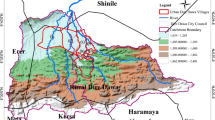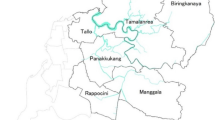Abstract
Global environmental change is bringing extreme precipitation, and the combination of natural and artificial impacts are resulting in serious floods on the west coast of Taiwan. Disparity in social, economic and infrastructure resources contributes to spatial variation in the vulnerability to flood disaster. Owing to the high frequency of torrential rain and serious land subsidence in the study area, this paper attempts to categorize vulnerability indicators under varied assumptions of spatial homogeneity and spatial heterogeneity. The results show that the spatial heterogeneity indeed affects the distribution of flood vulnerability indicators. The core value of this article is that it measures the improvement from using geographically weighted statistics rather than traditional statistics. For the flood vulnerability discussion, this paper demonstrates the importance of considering spatial heterogeneity when allocating resources against floods.







Similar content being viewed by others
Notes
A township refers to an administrative division contained within a county. Yunlin County, which contains the study area, contains 20 townships.
A village refers to a basic autonomous unit that is below the level of a township.
Vulnerability = Exposure + Susceptibility − Resilience.
References
Abdi H, Williams LJ (2010) Principal component analysis. Wiley Interdisciplin Review Comput Stat 2:433–459
Balica SF (2007) Development and Application of Flood Vulnerability Indices for Various Spatial Scales, United Nations Educational, Scientific and Cultural Organization, Delft, the Netherlands-IHE Institute for Water Education
Balica SF (2012) Applying the flood vulnerability index as a knowledge base for flood risk assessment. Delft University of Technology, Delft
Balica SF, Douben N, Wright NG (2009) Flood vulnerability indices at varying spatial scales. W Sci Technol 60(10):2571–2580
Barnett J, Lambert S, Fry I (2008) The hazards of indicators: insights from the environmental vulnerability index. Ann Assoc Am Geogr 98(1):102–119
Beek E (2006) Water resources development. UNESCO-IHE Institute, Delft
Bizikova L, Bellali J, Habtezion Z, Diakhite M, Pinter L (2009) IEA Training Manual Volume Two: Vulnerability and Impact Assessments for Adaptation to Climate Change (via Module), United Nations Environment Program (United Nations Environment Program), Kenya
Bruijn KM, Klijn F (2009) Risky places in the Netherlands: a first approximation for floods. J Flood Risk Manag 7:58–67
Cardona OD (2003) A need for rethinking the concept of vulnerability and risk from a holistic perspective: a necessary review and criticism for effective risk management. Available at: http://www.la-red.org/public/articulos/2003/nrcvrfhp/nrcvrfhp_ago-04-2003.pdf. Accessed 1 Mar 2016
Connor RF, Hiroki K (2005) Development of a method for assessing flood vulnerability. W Sci Technol 51(5):61–67
Cutter SL, Mitchell JT, Scott MS (1997) Handbook for conducting a GIS-Based hazards assessment at the Local Level. Report, South Carolina Emergency Preparedness Division, and Hazards Research Laboratory, Department of Geography, University of South Carolina
Cutter SL, Boruff BJ, Shirley WL (2003) Social vulnerability to environmental hazards. Soc Sci Quart 84(2):242–261
de Leon V, Carlos J (2006) Vulnerability—a conceptual and methodological review, vol 4. UNU Economic History Society, Bonn
Demšar U, Harris P, Brunsdon C, Fotheringham AS, McLoone S (2013) Principle component analysis on spatial data: an overview. Ann Assoc Am Geogr 103(1):106–128
Di Nauro C (2006) Regional vulnerability map for supporting policy definitions and implementation. In: Proceedings of the applied multi-risk mapping of natural hazards for impact assessment (ARMONIA), in Barcelona, Spain, pp. 1–12
Dilley M (2005) Natural disaster hotspots: a global risk analysis. World Bank, Washington
Eakin H, Lerner A, Murtinho F (2010) Adaptive capacity in evolving peri-urban spaces: responses to flood risk in the Upper Lerma River Valley, Mexico. Glob Env Chang 20:14–22
Doubem KJ (2006) Characteristics of river floods and flooding: a global overview, 1985–2003. Irrig Drain 55:S9–S21
Environment Canada (1997) The Canada country study: climate impacts and adaptation, national summary for policymakers, Ottawa
Fotheringham AS, Brunsdon C, Charlton ME (2002) Geographically weighted regression: the analysis of spatially varying relationships. Wiley, Chichester
Gallopín GC (2006) Linkages between vulnerability, resilience, and adaptive capacity. Glob Environ Change 16(3):293–303
Gaume E, Gaál L, Viglione A, Szolgay J, Kohnová S, Blöschl G (2010) Bayesian MCMC approach to regional flood frequency analyses involving extraordinary flood events at ungauged sites. J Hydrol 394(1–2):101–117
Harris P, Brunsdon C, Charlton M (2011) Geographically weighted principal components analysis. Int J Geogr Inf Sci 25(10):1717–1736
Harris P, Clarke A, Juggins S, Brunsdon C, Charlton M (2014) Enhancements to a geographically weighted princiap component analysis in the context of an application to an environmental data set. Geogr Anal 47(2):146–172
Haughton, J (2004) Living with environment change: social vulnerability, adaptation and resilience in Vietnam: Edited by W. Neil Adger, P. Mick Kelly, and Nguyen Huu Ninh. Routledge, London and New York, 2002. XXI + 314 pp., index, $90.00.”, Journal of Comparative Economics Vol. 32 No. 2, pp. 367–369
Hinkel J (2011) Indicators of vulnerability and adaptive capacity: towards a clarification of the science–policy interface. Glob Environ Change 21(1):198–208
Hotelling H (1933) Analysis of a Complex of Statistical Variables into Principal Components. J Educ Psychol 24:417–441
Hung HC, Chen LY (2012) An integrated assessment of vulnerability to typhoon and flood hazard in the ta-Chia river basin. J Geogr Sci 65:79–96
IPCC (Intergovernmental Panel on Climate Change) (2014) Climate Change 2014: Impacts, Adaptation, and Vulnerability, A Special Report of Working Groups II of the Intergovernmental Panel on Climate Change, Cambridge University Press, Cambridge, UK and New York
Khan S (2012) Vulnerability assessments and their planning implications: a case study of the Hutt Valley. N Z Nat Hazards 64(2):1587–1607
Klein R (2004) Vulnerability indices—an academic perspective. In: Proceedings of the Expert Meeting, “Developing a Method for Addressing Vulnerability to Climate Change and Climate Change Impact Management: to Index or Not to Index?”, Bonn, Germany
Leichenko RM, O’Brien KL (2002) The dynamics of rural vulnerability to global change: the case of Southern Africa. Mitig Adapt Strateg Glob Change 7(1):1–18
Li J, Tan S (2015) Nonstationary flood frequency analysis for annual flood peak series, adopting climate indices and check dam index as covariates. W Resour Manag 29(5):5533–5550
Li JZ, Wang YX, Li SF, Hu R (2015) A nonstationary standardized precipitation index incorporating climate indices as covariates. J Geophys Res Atmos 120(23):12082–12095
Liverman DM (1990) Vulnerability to Global Change, Clark University, Earth Transformed Program, Worcester
Lloyd CD (2010) Analysing population characteristics using geographically weighted principal components analysis: a case study of Northern Ireland in 2001. Comput Enviro Urban Syst 34(5):389–399
Mehaffey ML, Wainger T, Wade D, Yankee E, Smith VB, Yarbourgh R (2008) Assessing vulnerability from alternative development patterns. Landsc Urban Plan 87(1):84–95
Messner F, Meyer V (2005) Flood damage, vulnerability and risk perception–challenges for flood damage research. UFZ-Umweltforschungszentrum, Leipzig
Milly PCD, Betancourt J, Falkenmark M, Hirsch RM, Kundzewicz ZW, Lettenmaier DP, Stouffer RJ (2008) Stationarity is dead: whither water management? Science 319(5863):573–574
Nandi D, Ashour AS, Samanta S, Chakraborty S, Salem MAM, Dey N (2015) Principle component analysis in medical image processing: a study. Int J Image Min 1(1):65–86
Obeysekera J, Salas JD (2014) Quantifying the uncertainty of design floods under nonstationary conditions. J Hydrol Eng 19(7):1438–1446
Pelling M (2003) The vulnerability of cities. In: Pelling M (ed) Natural disaster and social resilience. Earthscan Publications, Sterling
Shi Y (2013) Population vulnerability assessment based on scenario simulation of rainstorm-induced waterlogging: a case study of Xuhui District, Shanghai City. Nat Hazard 66(2):1189–1203
Smit B, Wandel J (2006) Adaptation, adaptive capacity and vulnerability. Glob Environ Change 16(3):282–292
Smith K (2001) Environmental hazards: assessing risk and reducing disaster. Routledge, London
Sterr RK, Klein RJ, Reese S (2003) Climate change and costal zones: an overview of the state-of-the-art on regional and local vulnerability assessment. In: Giupponi C, Shechlter M (eds) Climate change in the Mediterranean socio-economic perspective of impacts vulnerability and adaptation. Edward Elgar Publishing House, Cheltenham, pp 245–278
Strupczewski WG, Kochanek KM, Bogdanowicz E, Markiewicz I, Feluch W (2016) Comparison of two nonstationary flood frequency analysis methods within the context of the variable regime in the representative Polish rivers. Acta Geophys 64(1):206–236
Sun AL, Shi C, Shi Y (2009) The preliminary inquiry of flood vulnerability space changes in coastal provinces and autonomous regions. Environ Sci Manag 34(3):36–40
Sun X, Lall U, Merz B, Dung NV (2015) Hierarchical Bayesian clustering for nonstationary flood frequency analysis: application to trends of annual maximum flow in Germany. W Resour Res 51(8):6586–6601
Tabachnick BG, Fidell LS (2006) Using multivariate statistics, 5th edn. Allyn & Bacon, Needham
Tobler WR (1970) A computer movie simulating urban growth in the Detroit region. Econ Geogr 46(Supplement):234–240
Turner BL, Kasperson RE, Matson PA, McCarthy JJ, Corell RW, Christensen L, Eckley N, Kasperson JX, Luers A, Martello ML, Polsky C, Pulsipher A, Schiller A (2003) A framework for vulnerability analysis in sustainability science. Proc Nat Acad Sci USA 100(14):8074–8079
UN (2015) Sendai framework for disaster risk reduction 2015–2030. United Nations Office for Disaster Risk Reduction
UN/ISDR (2007) Hyogo framework for action 2005–2015: building the resilience of nations and communities to disasters. UN/ISDR, Geneva
UNESCO-IHE (2007) Annual Report 2007. UNESCO-IHE Institute for Water Education
Villagrán C, Hazle G, Barrera F (2005) Hepáticas y Antocerotes del Archipiélago de Chile. Ediciones Museo Nacional de Historia Natural
Villarini G, Smith JA, Serinaldi F, Bales J, Bates PD, Krajewski WF (2009) Flood frequency analysis for nonstationary annual peak records in an urban drainage basin”. Adv W Resour 32(8):1255–1266
Walker G, Burningham K (2011) Flood risk, vulnerability and environmental justice: evidence and evaluation of inequality in a UK context. Crit Soc Polic 31(2):216–240
Wong DWS, Lee J (2008) Statistical analysis of geographic information with ArcView GIS and ArcGIS. Wiley, Chichester
Wu ZP, Hsiung KH (2009) Spatial analysis of urban fire risk. Chung Hua J Archit 3(3):1–12
Wu JY, Huang YS (2011) The establishment of vulnerability evaluation indexed: the case of Shueili township, Nantou Taiwan. City Plan 38(2):195–218
Author information
Authors and Affiliations
Corresponding author
Rights and permissions
About this article
Cite this article
Chang, HS., Chen, TL. Spatial heterogeneity of local flood vulnerability indicators within flood-prone areas in Taiwan. Environ Earth Sci 75, 1484 (2016). https://doi.org/10.1007/s12665-016-6294-x
Received:
Accepted:
Published:
DOI: https://doi.org/10.1007/s12665-016-6294-x




